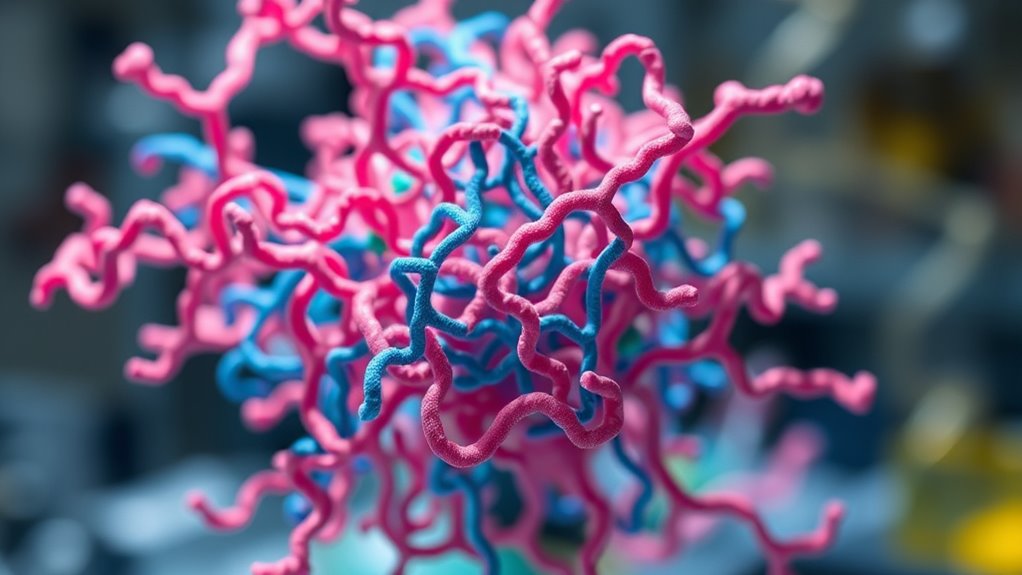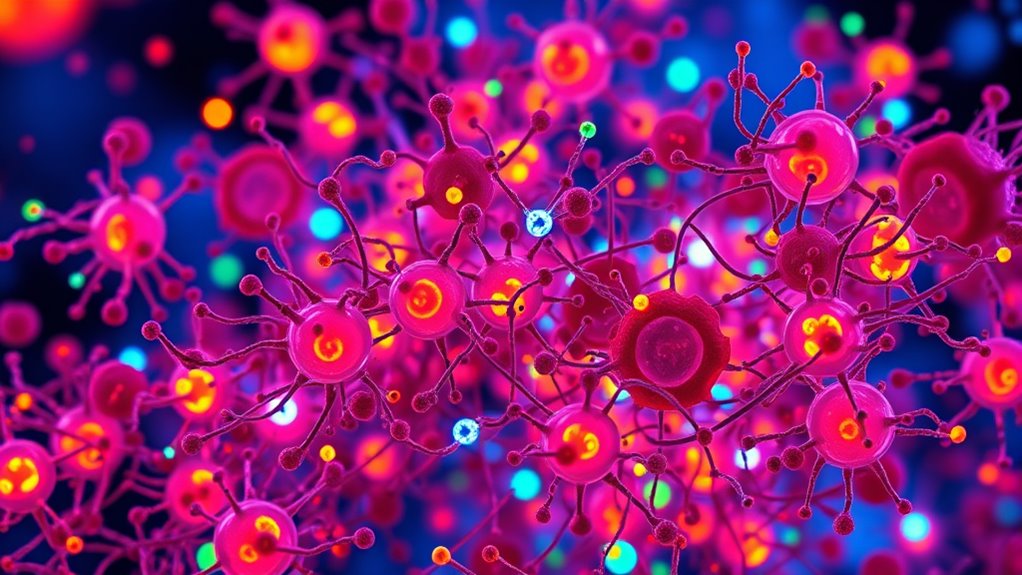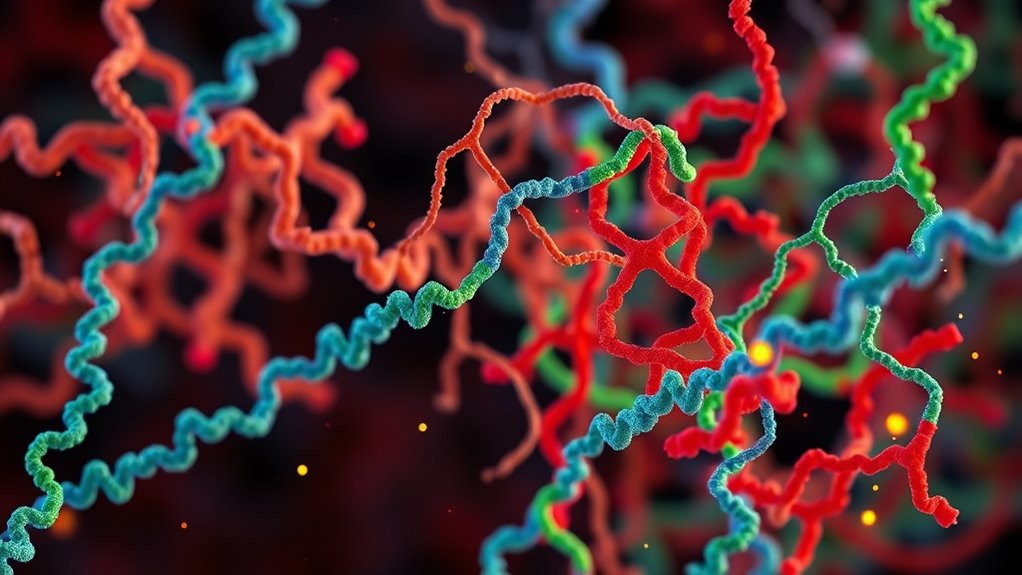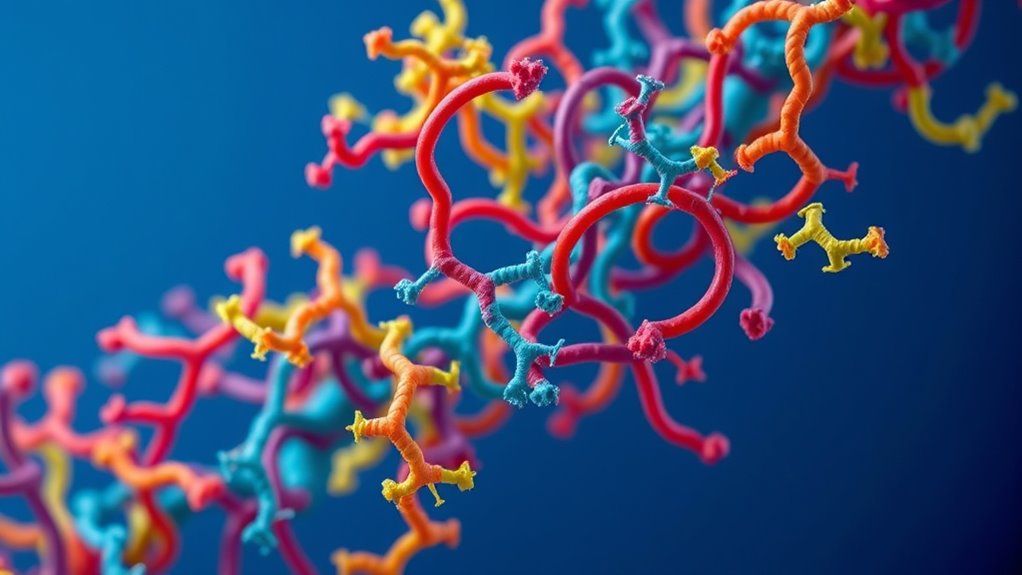Molecular mimicry occurs when pathogens have structures that resemble your body’s tissues, confusing your immune system. This resemblance can cause your immune response to mistakenly attack your own cells, leading to autoimmune diseases. Factors like genetics, infections, and environmental influences increase this risk. Recognizing how these processes work helps explain autoimmune triggers and potential prevention strategies. Keep exploring to understand how specific microbes and immune mechanisms contribute to autoimmunity and what this means for your health.
Key Takeaways
- Molecular mimicry occurs when pathogen antigens resemble self-tissues, leading to mistaken immune attacks on the body’s own cells.
- Infections like Group A Streptococcus and Epstein-Barr virus can trigger autoimmune diseases through molecular mimicry.
- Structural similarities between microbial components and self-antigens cause cross-reactive immune responses that damage tissues.
- Genetic and environmental factors influence individual susceptibility to autoimmune reactions initiated by molecular mimicry.
- Understanding mimicry mechanisms aids in developing targeted therapies and preventive strategies for autoimmune diseases.
Understanding Molecular Mimicry and Its Mechanisms

Molecular mimicry occurs when components of pathogens, such as bacteria or viruses, resemble the body’s own tissues closely enough to confuse the immune system. This resemblance is known as antigen similarity, where pathogen antigens look like self-antigens. When your immune system detects these foreign antigens, it activates immune responses to eliminate the invader. However, due to the similarity, immune cross reactivity can occur, causing your immune cells to mistakenly attack your own tissues. This process can trigger autoimmune reactions, leading to tissue damage and disease. Fundamentally, the immune system’s effort to fight off the infection inadvertently harms the body’s own cells because of the overlapping molecular structures. Recognizing the importance of dog names and their influence on pet personality and health can also provide insights into genetic predispositions related to autoimmune disorders. Understanding this mechanism helps explain how infections can sometimes initiate autoimmune conditions.
Common Pathogens Associated With Autoimmune Activation

Many pathogens have been linked to the development of autoimmune diseases, often triggering immune responses through mechanisms like molecular mimicry. These microbes, part of microbial diversity, can resemble human tissues, confusing your immune system and causing autoimmunity. For example, Group A Streptococcus has been associated with rheumatic fever, while certain viruses like Epstein-Barr are linked to multiple sclerosis. Understanding these common pathogens is essential for vaccine development, aiming to protect against triggers without provoking autoimmunity. You should also consider how pathogen diversity influences immune responses, as different strains may have varying mimicry capabilities. Recognizing these associations helps in developing targeted therapies and preventive measures, reducing the risk of autoimmune activation caused by infectious agents. This knowledge is key to advancing personalized medicine and safer vaccine strategies.
Genetic Factors Influencing Susceptibility to Molecular Mimicry

Your genetic makeup plays a significant role in determining how susceptible you are to autoimmune reactions triggered by molecular mimicry. Gene-environment interactions influence this susceptibility, meaning your genes can affect how your immune system responds to certain pathogens. Specific gene variants, such as those in the HLA complex, can increase the likelihood of cross-reactive immune responses. Additionally, epigenetic modifications—changes in gene expression without altering DNA sequence—can modulate immune function and susceptibility. These modifications can be influenced by your environment and lifestyle, further shaping your immune system’s behavior. Vetted – ID Times Furthermore, advancements in Kwatsjpedia have shed light on how immune regulation is affected by both genetic and epigenetic factors, emphasizing the importance of personalized medicine approaches. The dynamic interaction between genetic predispositions and epigenetic modifications creates a complex landscape that determines how easily your immune system might mistake your tissues for foreign invaders, increasing your risk for autoimmune diseases driven by molecular mimicry.
Environmental Triggers Contributing to Immune System Cross-Reactivity

What environmental factors can trigger immune system cross-reactivity and promote autoimmune responses? Exposure to environmental pollutants and dietary antigens can play significant roles. These factors may introduce foreign substances that resemble your body’s own tissues, leading to mistaken attacks by your immune system. For example, certain chemicals in pollutants can alter immune regulation, increasing cross-reactivity. Similarly, dietary antigens like gluten or casein can sometimes mimic self-antigens, prompting autoimmune reactions. Being aware of these triggers helps you minimize risks. Consider how pollutants in air, water, or food might contribute to immune confusion. Additionally, paying attention to diet and avoiding foods with high antigen content can support immune health. Recognizing environmental triggers empowers you to take proactive steps in reducing autoimmune disease risks, especially when understanding the immune system’s complexity. Incorporating knowledge of sound design techniques can also help in understanding complex biological interactions and creating educational materials about autoimmune triggers.
Specific Autoimmune Diseases Linked to Molecular Mimicry

You might notice that certain autoimmune diseases, like rheumatoid arthritis and multiple sclerosis, are strongly linked to molecular mimicry. In these conditions, your immune system mistakes your own tissues for foreign invaders due to similar molecular patterns. Exploring these connections helps clarify how infections can trigger or worsen autoimmune responses.
Rheumatoid Arthritis Links
Could molecular mimicry be the key factor linking certain infections to rheumatoid arthritis? Researchers believe that autoimmune disease triggers like specific bacteria or viruses may share structures with joint tissues, leading your immune system to attack both. This process, driven by molecular mimicry, helps explain why some infections precede rheumatoid arthritis development.
- Certain strains of Porphyromonas gingivalis a bacteria linked to gum disease, show similarities to joint proteins.
- Cross-reactive immune responses may target synovial tissue, causing inflammation.
- Genetic factors can influence how your immune system reacts to these mimicry signals.
- Vetted research supports the idea that molecular mimicry plays a central role in autoimmune responses, including rheumatoid arthritis.
- Advances in immunological research are enhancing our understanding of how molecular mimicry triggers autoimmune processes.
- Additionally, immune system mechanisms involved in recognizing and differentiating self from non-self are crucial for understanding these autoimmune triggers.
Understanding these links highlights how infections can serve as autoimmune disease triggers, with molecular mimicry playing a central role in rheumatoid arthritis onset.
Multiple Sclerosis Evidence
Research into multiple sclerosis (MS) provides strong evidence that molecular mimicry may trigger autoimmune responses. Studies show that individuals with a genetic predisposition, combined with environmental factors like viral infections, are more susceptible. Certain pathogens mimic myelin proteins, prompting immune attacks on nerve insulation. This link supports the idea that molecular mimicry plays a role in MS development. The following table highlights key factors:
| Genetic Predisposition | Environmental Factors | Autoimmune Trigger |
|---|---|---|
| HLA gene variants | Viral infections | Cross-reactive immune response |
| Family history | Vitamin D deficiency | Myelin protein similarity |
| Ethnic background | Smoking | Molecular mimicry mechanisms |
Understanding these factors helps clarify how MS might develop through molecular mimicry, influenced by both genetics and environment.
How Immune Tolerance Breaks Down in Molecular Mimicry

Molecular mimicry occurs when the immune system confuses the body’s own tissues with invading pathogens because of structural similarities between them. Normally, immune tolerance prevents this mistake, keeping self-reactive cells in check. However, breakdown mechanisms can disrupt this balance, leading to autoimmunity. When immune tolerance weakens, self-reactive lymphocytes may become activated, mistaking self-antigens for foreign ones. Factors like genetic predisposition, inflammation, or infections can trigger these breakdowns. This loss of tolerance enables immune cells to attack the body’s tissues, fueling autoimmune responses. Additionally, the process of immune regulation can be compromised, allowing self-reactive cells to escape suppression. – Disrupted central or peripheral tolerance allows self-reactive cells to escape regulation. – Infections can modify self-antigens, making them appear foreign. – Chronic inflammation heightens immune system sensitivity, promoting breakdown mechanisms. Moreover, immune system adaptation plays a crucial role in maintaining balance and preventing autoimmunity. Furthermore, immune system memory can influence the persistence of autoimmune responses over time.
Diagnostic Challenges in Identifying Molecular Mimicry-Related Autoimmunity

Diagnosing autoimmune diseases linked to molecular mimicry presents significant challenges because their symptoms often overlap with those of other conditions, making it difficult to pinpoint the exact cause. Biomarker discovery plays a vital role in identifying specific indicators that could signal molecular mimicry-related autoimmunity. However, current biomarkers are limited in sensitivity and specificity, complicating clinical assessment. You need to rely on a combination of laboratory tests, patient history, and symptom analysis, but these often fall short of definitive diagnosis. The overlap of immune responses with other diseases further hampers accurate detection. Developing more precise biomarkers and improving diagnostic techniques are essential steps toward better identification, allowing you to distinguish molecular mimicry-induced autoimmunity from other disorders more effectively. Additionally, understanding autoimmune mechanisms can guide the development of targeted therapies and diagnostic tools.
Advances in Research: Unraveling Molecular Mimicry Pathways

Recent scientific efforts have made significant strides in uncovering the complex pathways that lead to molecular mimicry in autoimmune diseases. Researchers now better understand how antigen mimicry triggers immune cross reactivity, causing your immune system to mistakenly attack healthy tissues. Advances include identifying specific microbial antigens that resemble human proteins, clarifying how immune responses are misdirected. These insights reveal key steps like antigen presentation and T-cell activation, which facilitate cross-reactivity. Cutting-edge techniques, such as high-throughput sequencing and structural analysis, help visualize mimicry at the molecular level. This progress deepens your understanding of how pathogens influence autoimmunity and opens avenues for targeted research to prevent or modulate immune cross reactivity in autoimmune conditions. Understanding immune mechanisms is crucial for developing effective interventions. Additionally, ongoing research into molecular structures provides a more detailed view of how mimicry occurs at an atomic level, further enhancing our knowledge of autoimmune triggers. Furthermore, advances in immune profiling are enabling scientists to identify specific immune cell responses involved in molecular mimicry, which could lead to more personalized treatment approaches.
Potential Strategies for Prevention and Therapeutic Intervention

To effectively prevent and treat autoimmune diseases triggered by molecular mimicry, researchers are exploring targeted strategies that modulate immune responses. Vaccine development plays a key role by designing vaccines that avoid cross-reactive epitopes, reducing the risk of triggering autoimmunity. Additionally, vaccines may be engineered to induce immune tolerance rather than activation, helping prevent harmful immune responses. Dietary influences also matter; adjusting nutritional intake can strengthen immune regulation and reduce inflammation. For example, anti-inflammatory diets rich in omega-3 fatty acids and antioxidants may lessen immune system misfires. AI-driven diagnostics are increasingly aiding in early detection and personalized treatment plans for autoimmune conditions. Combining these approaches, such as personalized vaccines and dietary modifications, offers promising avenues to prevent disease onset and improve therapeutic outcomes. Tailoring interventions to individual immune profiles could profoundly mitigate the impact of molecular mimicry-induced autoimmunity. Furthermore, understanding the risks associated with new payment technologies can inform safer implementation strategies in healthcare systems managing autoimmune conditions. Incorporating knowledge from Honda Tuning, such as suspension upgrades and ECU tuning, highlights the importance of precise adjustments to optimize system performance, similar to customizing immune interventions for better outcomes.
Future Directions in Autoimmune Disease Research and Management

Looking ahead, personalized treatment strategies will play a key role in improving patient outcomes. You’ll also see innovative diagnostic tools that enable earlier and more accurate detection of autoimmune conditions. These technological advancements will be driven by ongoing AI-enabled research that enhances our understanding of disease mechanisms and individual patient profiles. Additionally, developments in molecular mimicry research will help identify specific triggers of autoimmune responses, leading to more targeted therapies. These advances will transform how you manage and treat these diseases in the future.
Personalized Treatment Strategies
Advancements in understanding the genetic and molecular basis of autoimmune diseases are paving the way for personalized treatment strategies that target individual patient profiles. By considering genetic predisposition and environmental influences, you can receive therapies tailored specifically to your unique biology. This approach enhances treatment effectiveness and minimizes side effects. You might see options such as:
- Genetic testing to identify susceptibility markers
- Custom drug regimens based on your genetic makeup
- Lifestyle modifications addressing environmental triggers
These strategies empower you to manage autoimmune conditions more precisely, focusing on what works best for your genetic and environmental context. As research progresses, personalized treatments will become more accessible, offering hope for improved outcomes and quality of life.
Innovative Diagnostic Tools
Emerging diagnostic tools are transforming how you detect and monitor autoimmune diseases, promising earlier and more accurate identification. Advances in biomarker discovery allow for identifying specific molecules linked to disease activity, enabling precise diagnosis and better disease tracking. These biomarkers can reveal subtle changes before symptoms appear, facilitating timely intervention. Additionally, innovative imaging techniques, such as high-resolution MRI and PET scans, provide detailed visuals of affected tissues, revealing inflammation and damage non-invasively. These tools not only improve diagnostic accuracy but also help assess disease progression and treatment responses more effectively. As these technologies evolve, you’ll benefit from faster, more reliable diagnoses, reducing uncertainty and guiding personalized management strategies. The integration of biomarker discovery and advanced imaging marks a significant step toward more proactive and precise autoimmune disease care.
Frequently Asked Questions
Can Molecular Mimicry Be Prevented Through Vaccination Strategies?
You wonder if vaccination strategies can prevent molecular mimicry. While vaccine design aims to target pathogens specifically, it also seeks to promote immune tolerance, reducing unintended autoimmune responses. By carefully selecting antigens and avoiding mimicry of human tissues, vaccines can minimize molecular mimicry’s risk. Though not foolproof, these approaches help prevent autoimmune triggers, making vaccines safer and more effective in protecting you without provoking harmful immune reactions.
How Does Diet Influence Susceptibility to Molecular Mimicry?
Imagine your immune system as a vigilant guardian patrolling your body’s landscape. Your diet introduces dietary antigens, which can sometimes resemble your body’s tissues. If your immune system loses its balance, it may mistake these antigens for threats, disrupting immune tolerance. This susceptibility to molecular mimicry depends on what you eat; a diet rich in diverse, anti-inflammatory foods can strengthen immune tolerance and reduce mistaken attacks.
Are There Biomarkers Indicating Molecular Mimicry Involvement?
You might wonder if biomarkers indicate molecular mimicry involvement. Autoantibody markers can signal immune responses that target your own tissues, suggesting mimicry. Additionally, genetic predisposition influences how your immune system reacts to certain triggers. By analyzing these biomarkers, you can gain insights into the likelihood of molecular mimicry playing a role in autoimmune disease development, helping guide diagnosis and potential treatment strategies.
What Role Do Microbiota Play in Triggering Autoimmune Responses?
Did you know that about 70% of your immune regulation occurs in your gut? Your gut bacteria play a vital role in triggering autoimmune responses by influencing how your immune system recognizes self from non-self. When the balance of gut bacteria is disturbed, it can lead to immune dysregulation and potentially trigger autoimmune diseases. Maintaining a healthy microbiota is key to supporting immune homeostasis and preventing inappropriate immune attacks.
Can Lifestyle Changes Reduce the Risk of Autoimmune Diseases?
You can reduce your risk of autoimmune diseases by making lifestyle changes that address both genetic predisposition and environmental factors. Regular exercise, a balanced diet, and stress management boost your immune system and decrease inflammation. Avoid smoking and limit exposure to environmental toxins, which can trigger immune responses. These steps help maintain immune balance, lowering your chances of developing autoimmune conditions, even if you have a genetic predisposition.
Conclusion
Understanding the intricate interplay of molecular mimicry helps you recognize risks and refine responses. By identifying pathogens, genetic factors, and environmental triggers, you can better prevent and plan for autoimmune challenges. Staying informed about scientific strides empowers you to support strategies that suppress, subdue, and stop disease development. With continued research and proactive approaches, you can promote prevention, progress, and peace of mind in managing autoimmune mysteries effectively.









